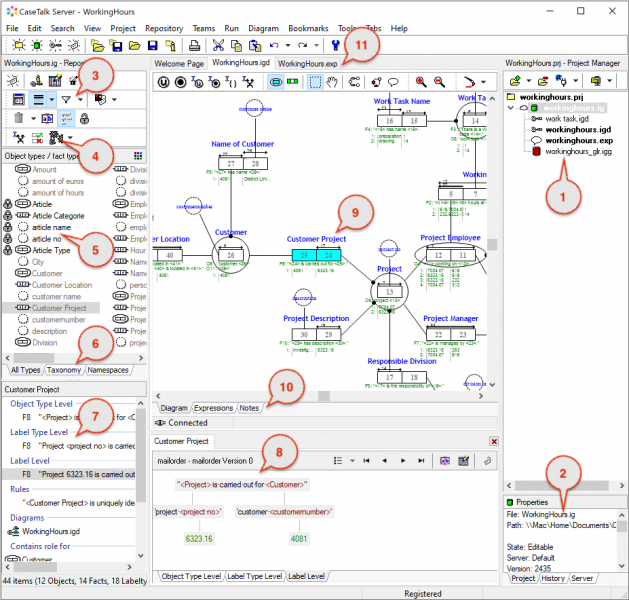Difference between revisions of "Model Navigation"
| Line 8: | Line 8: | ||
== Object & Fact Types (5) == | == Object & Fact Types (5) == | ||
Model content (*.ig) or transformed model content (*.igg) is listed as Object/Fact Types in the panel on the left. Buttons indicated with (3) are used for highlighting and filtering. Using the highlight the displayed items are shown differently. The filtering options allow certain items to be shown or hidden. | Model content (*.ig) or transformed model content (*.igg) is listed as Object/Fact Types in the panel on the left. Buttons indicated with (3) are used for highlighting and filtering. Using the highlight the displayed items are shown differently. The filtering options allow certain items to be shown or hidden. | ||
== Expressions (7) == | == Expressions, Population and Rules (7) == | ||
The verbalisations lead to the Object and Fact Types. So by selecting an Object/Fact Type the details of that item show up in a bottom panel (7). The double clicking of an expression will open panel (8) the full expression tree. | The verbalisations lead to the Object and Fact Types. So by selecting an Object/Fact Type the details of that item show up in a bottom panel (7). The double clicking of an expression will open panel (8) the full expression tree. | ||
Scrolling this panel will show all kinds of verbalizations, rules and attributes. Some are again supporting navigation by doubleclicks. | |||
* Diagram & Styles | * Diagram & Styles | ||
* Project archives (2) | * Project archives (2) | ||
Revision as of 04:49, 14 November 2020
With any large model, and becomes even larger, navigating the quantity of it can become an issue. CaseTalk offers many navigation paths to enable you to quickly jump to related aspects. This screenprint shows an overview and describes how to perform these navigational tasks.
Project File (1) & Properties (2)
The models and diagrams are managed with the Project Panel. It shows all files related and a special panel with file details. Files are activated by doubleclicking them. Models are displayed on the left, while all other files will open as tabs (11).
Object & Fact Types (5)
Model content (*.ig) or transformed model content (*.igg) is listed as Object/Fact Types in the panel on the left. Buttons indicated with (3) are used for highlighting and filtering. Using the highlight the displayed items are shown differently. The filtering options allow certain items to be shown or hidden.
Expressions, Population and Rules (7)
The verbalisations lead to the Object and Fact Types. So by selecting an Object/Fact Type the details of that item show up in a bottom panel (7). The double clicking of an expression will open panel (8) the full expression tree.
Scrolling this panel will show all kinds of verbalizations, rules and attributes. Some are again supporting navigation by doubleclicks.
- Diagram & Styles
- Project archives (2)
Transformations (4)
The strongest feature on CaseTalk is the ability to transform models for artifact generation. The IG file content is transformed into a new model and stored in a IGG file. Before that happens the model is validated for well-formedness. The result of that validation will be shown in a special panel at location (8). Once the transformation is successful the resulting artifacts will be added to the Project Panel and can be viewed by doubleclicking those files.
- Repository Internals
More details, and how to navigate between them needs to be enumerated here...
